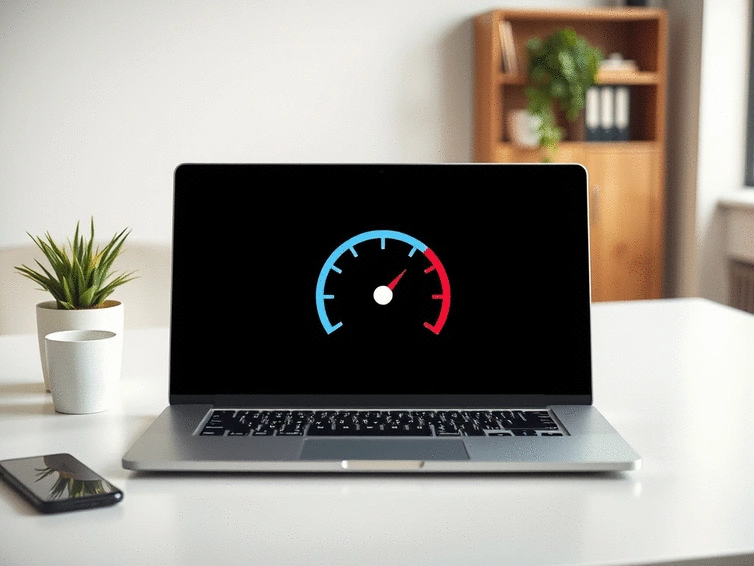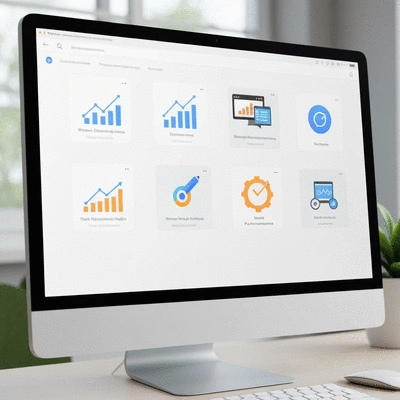
Optimize Your Site Speed Easily
Did you know that a mere one-second delay in site loading time can lead to a staggering drop in conversion rates? In today’s fast-paced digital world, where every second counts, site speed is more crucial than ever for maintaining user engagement and search engine rankings.
What You Will Learn
- The critical impact of site speed on user experience and SEO rankings.
- How Core Web Vitals are essential for measuring user interactions on your website.
- The importance of server response time and how to optimize it for better performance.
- Key strategies for improving site speed, including technical audits and image optimization.
- Recommended tools for monitoring and enhancing website performance.
The Core Web Vitals: Key Metrics for SEO Success
Google's Core Web Vitals measure real-world user experience and are crucial for search rankings. Optimizing these metrics improves both user satisfaction and SEO.
Largest Contentful Paint (LCP)
Measures loading performance. The time it takes for the largest content element to become visible.
First Input Delay (FID)
Measures interactivity. The time from when a user first interacts with a page to when the browser responds.
Cumulative Layout Shift (CLS)
Measures visual stability. The unexpected shifting of visual page content.
Server Response Time
The duration for your server to respond to a browser request, impacting overall loading speed.
Understanding Site Speed: Why It Matters for SEO
Are you aware of how critical site speed is for your website? It’s not just a technical term; it affects user experience and your SEO rankings. The faster your site loads, the more likely visitors will stay and engage with your content. If your pages take too long to load, users will bounce, leading to higher abandonment rates, and you can bet that search engines will take notice!
In today’s digital landscape, where patience is thin and expectations are high, optimizing your site speed is essential. Let's explore the many facets of site speed and its impact on your online presence.
Impact of Loading Time on User Experience and Rankings
Loading time can make or break a user’s experience on your website. Studies show that even a one-second delay can lead to a significant drop in conversions! When visitors have to wait, they might not only leave your site but also develop a negative perception of your brand. Therefore, keeping your site fast is crucial for retaining visitors and encouraging them to engage with your content.
- Improved user satisfaction
- Higher conversion rates
- Lower bounce rates
- Better rankings in search engine results
To put it simply, a fast-loading site can boost your credibility and enhance your online reputation. This is one of the reasons I emphasize speed optimization in my tutorials at All for Domains—it’s a game-changer for anyone looking to establish a solid online presence!
Exploring the Connection between Core Web Vitals and SEO Success
Have you heard about Core Web Vitals? These metrics measure the real-world experience of users on your site, as highlighted by web.dev. Google has incorporated these vitals into their ranking criteria, making them vital for success. The three main components are:
- Largest Contentful Paint (LCP): Measures loading performance.
- First Input Delay (FID): Measures interactivity.
- Cumulative Layout Shift (CLS): Measures visual stability.
By optimizing these aspects, you can not only improve user experience but also enhance your search rankings. It's a win-win! Keeping track of these metrics can lead to actionable insights that help you continuously improve your site, as detailed in Google's guidelines for optimizing site speed.

The Role of Server Response Time in Site Speed
Finally, let’s dive into server response time. This is the duration it takes for your server to respond to a request from the browser. A slow server can dramatically impact your loading times, even if everything else on your site is optimized. Factors affecting server response time include:
- Server configuration
- Hosting provider quality
- Traffic load management
- Database performance
By addressing these factors and choosing a reliable hosting provider, you can significantly improve your site's speed. At All for Domains, I often recommend evaluating your hosting service to ensure it meets your speed needs!
Pro Tip
To enhance your site speed effectively, consider utilizing a Content Delivery Network (CDN). A CDN stores cached versions of your website in various geographical locations, ensuring that users can access your content from a server that is physically closer to them. This reduces loading times significantly and improves overall user experience, which can lead to higher engagement and better SEO rankings. The W3C Performance Timing specification provides further insights into how browser performance metrics impact user experience.
Summarizing Key Takeaways for Effective Site Speed Optimization
As we wrap up our discussion on site speed, it's essential to focus on the key takeaways that can truly make a difference in your website's performance. Site speed isn’t just a technical metric; it directly affects user experience, engagement, and ultimately, your SEO rankings. By implementing the right strategies, you can ensure that your site loads quickly and efficiently.
Here’s a quick overview of the essential steps we've covered for optimizing your site speed:
- Conduct a comprehensive technical audit using tools like Google PageSpeed Insights.
- Optimize images and media by compressing them and implementing lazy loading.
- Utilize caching strategies to reduce load times, including browser and page caching.
- Leverage CDNs to enhance content delivery across the globe.
- Choose the right hosting solution that aligns with your speed needs.
- Adopt advanced techniques such as HTTP/2 and resource hints for better performance.
By focusing on these areas, you'll not only improve your site speed but also enhance the overall user experience, leading to better retention and conversion rates.

Reviewing the Essential Steps and Tools for Success
Reviewing the steps and tools at your disposal is crucial for effective site speed optimization. Each element plays a part in creating a seamless experience for your visitors. Let’s break down the tools and techniques you should keep in mind:
- Technical Audit Tools: Google PageSpeed Insights and DebugBear
- Image Optimization Tools: TinyPNG for compression and proper formats
- Performance Monitoring: Google CrUX for ongoing assessments
- CDN Options: Cloudflare and Amazon CloudFront for effective content delivery
- Caching Solutions: Redis or Memcached for object caching
Utilizing these tools ensures that you have the right support system in place to monitor and enhance your site's performance over time.
Frequently Asked Questions About Site Speed Optimization
- Q: What are Core Web Vitals and why are they important for SEO?
- A: Core Web Vitals are a set of metrics from Google that measure real-world user experience for loading performance (Largest Contentful Paint), interactivity (First Input Delay), and visual stability (Cumulative Layout Shift). They are crucial because Google includes them in its ranking criteria, directly impacting a website's search engine visibility.
- Q: How does site speed affect user experience and conversion rates?
- A: Site speed significantly impacts user experience. A slow-loading site can lead to higher bounce rates and lower user engagement. Even a one-second delay can drastically reduce conversion rates, as users expect fast and seamless interactions with websites.
- Q: What is server response time and how can it be optimized?
- A: Server response time is the duration it takes for your server to respond to a browser's request. It's a critical factor in overall loading speed. Optimization involves fine-tuning server configuration, choosing a high-quality hosting provider, efficient traffic load management, and optimizing database performance.
- Q: What are some key strategies for improving site speed?
- A: Key strategies include conducting technical audits with tools like Google PageSpeed Insights, optimizing images and media (compression, lazy loading), implementing caching strategies (browser, page caching), leveraging Content Delivery Networks (CDNs), choosing appropriate hosting, and utilizing advanced techniques like HTTP/2 and resource hints.
- Q: What tools are recommended for monitoring and enhancing website performance?
- A: Recommended tools include Google PageSpeed Insights and DebugBear for technical audits, TinyPNG for image optimization, Google CrUX for performance monitoring, Cloudflare and Amazon CloudFront for CDN services, and Redis or Memcached for caching solutions.
Engaging Your Audience: Next Steps and Additional Resources
Now that you have a solid understanding of site speed optimization, it’s time to engage your audience further! Sharing knowledge and resources helps create a supportive community of online entrepreneurs.
Providing a Downloadable Checklist for Site Speed Optimization
To assist you on your journey, I’m excited to offer a downloadable checklist for site speed optimization. This checklist includes all the steps we've discussed, helping you implement strategies systematically. Be sure to check it out and keep it handy!
Encouraging Users to Share Their Experiences and Questions
I’d love to hear about your experiences with site speed optimization! What challenges have you faced, or what successes have you celebrated? Feel free to share your thoughts or any questions you have in the comments below. Engaging with each other can lead to valuable insights—let’s learn together!
With the right tools and strategies, you're well on your way to enhancing your website's performance. Remember, your journey doesn’t end here; it’s about continuous improvement and adaptation to keep your site running smoothly. Let’s connect and make your online presence thrive!
Recap of Key Points
Here is a quick recap of the important points discussed in the article:
- Site speed significantly impacts user experience and SEO rankings.
- A one-second delay in loading time can lead to increased bounce rates and decreased conversions.
- Core Web Vitals are essential metrics for measuring loading performance, interactivity, and visual stability.
- Optimizing server response time is crucial for maintaining fast loading speeds.
- Implement strategies like image optimization, caching, and using CDNs to enhance site speed.
- Regular technical audits with tools like Google PageSpeed Insights help maintain site performance.





Optimize Images for Better SEO
Free vs. Paid Web Hosting Costs
Avoid These Domain Name Mistakes
Choosing the Right SEO Tool
Protecting Your Domain from Hijacking